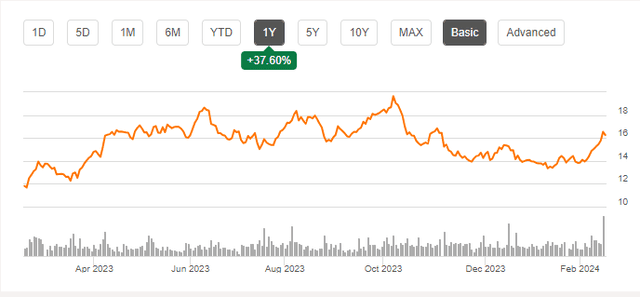The Federal Reserve Releases February Money Supply Data
March 28, 2024 | by stockcoin.net


The Federal Reserve has recently released the February money supply data, revealing no unexpected surprises. The data shows that M2, a measure of the money supply, continues to contract in relation to the economy, indicating a likely continuation of falling inflation. Although currency in circulation, which constitutes around 10% of M2, experienced a significant surge during the COVID-19 crisis, it is now returning to a 6.6% annual growth rate as life gradually returns to normal with the rollout of vaccines. This suggests a decrease in the demand for money, as uncertainty and limited spending opportunities during the pandemic subside. Additionally, the decrease in M2 growth and the implementation of higher interest rates have neutralized the excess money supply and reduced inflationary pressure. Furthermore, the data indicates a continued disinflation trend in the near future, particularly as shelter costs are expected to decline in the coming months. Overall, The Federal Reserve’s “abundant reserves” policy has effectively contributed to a “soft landing” scenario with decreasing inflation, avoiding a recession in the process.

Overview of February Money Supply Data
The Federal Reserve recently released the February money supply data, and there were no surprises in the release. The data shows that M2, which is a measure of the money supply, continues to shrink relative to the economy. This indicates that inflation is likely to continue falling.
Currency in Circulation and its Significance
Currency in circulation, which represents about 10% of M2, has been an important factor to consider. From 2010 until early 2020, there was a consistent rise in currency in circulation at an annual rate of 6.6%. However, during the COVID-19 crisis, there was a surge in currency in circulation.
This surge in currency in circulation suggests a high demand for money during the pandemic. With uncertainty and limited spending opportunities, individuals and businesses sought to hold more cash. As life returns to normal with the rollout of vaccines, the demand for money is subsiding. This is evident in the data, which shows a return to a 6.6% annual growth rate in currency in circulation.

Impact of M2 Growth and Interest Rates
The decrease in M2 growth, combined with higher interest rates, has had a significant impact on the economy. The reduction in M2 growth helps to neutralize excess money supply, which in turn reduces inflationary pressure. By controlling the growth of the money supply, the Federal Reserve can influence inflation levels.
Relationship between M2 Growth and CPI
Typically, changes in M2 growth precede changes in the CPI (Consumer Price Index) by about one year. However, in the past several months, the relationship between M2 growth and CPI changes has broken down. This is primarily due to the overestimation of shelter costs in CPI calculations.
The data suggests that there has been a discrepancy between the actual shelter costs experienced by individuals and the way these costs are calculated in the CPI. As a result, the inflationary impact of changes in M2 growth may not be accurately reflected in the CPI.
Continued Disinflation in the Pipeline
Looking ahead, there is an expectation of declining shelter costs, which will have implications for continued disinflation. The data suggests that in the next 6-8 months, there will be a decline in shelter costs, contributing to a further reduction in inflation levels. This is an important factor to consider for policymakers and investors alike.
Money Demand and the M2 to Nominal GDP Ratio
The ratio of M2 to nominal GDP serves as a measure of money demand. During the early months of the COVID-19 crisis, there was a surge in money demand as individuals and businesses sought to hold more cash for precautionary reasons. However, since then, money demand has been declining.
The declining money demand indicates a return to pre-pandemic levels. As the economy continues to recover and uncertainty subsides, individuals and businesses are less inclined to hold excess cash. This has implications for the overall money supply and inflation levels.
The Federal Reserve’s ‘Abundant Reserves’ Policy
The Federal Reserve has implemented an ‘abundant reserves’ policy to avoid a liquidity shortage in the banking system. The policy ensures that banks have sufficient reserves to meet their obligations and maintain stability. This has contributed to a ‘soft landing’ scenario, where inflation is decreasing without triggering a recession.
By carefully managing the money supply and interest rates, the Federal Reserve has been able to control inflation while supporting economic growth. This policy has been effective in maintaining stability and preventing excessive inflation without causing a downturn in the economy.
In conclusion, the recent February money supply data reaffirms the expectations of decreasing inflation. The shrinking M2 relative to the economy, along with the impact of high money demand during the pandemic and the Federal Reserve’s ‘abundant reserves’ policy, all contribute to a situation where inflation is likely to continue falling. However, it is important to closely monitor the relationship between M2 growth and CPI changes as well as the expected decline in shelter costs in the coming months. These factors will play a crucial role in determining the future trajectory of inflation and the overall economic landscape.

RELATED POSTS
View all





